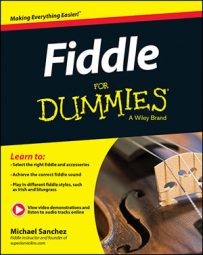Sometimes you’ll see various combinations of double-stops in fiddle tunes. Some are harder than others to play, and the difficulty isn’t just because of the notes but the rhythms and notes you have to play before the double-stop. Jumping around is possible, as well as using different finger positions to satisfy certain double-stops.
Here is a popular intro in fiddle music that sounds best when you combine double-stops. Doing so requires some unique positioning of your fingers.
![[Credit: Figure by Michael Sanchez]](https://www.dummies.com/wp-content/uploads/459333.image0.jpg)
Follow these steps to play this intro line with double-stops:
Put your 2nd finger down on the E string (G).
This finger will stay in this position throughout the intro. Make sure you keep your knuckles up high so that you can do the next part properly.
Put down your 1st finger on the A string (B) without hitting the E string.
Your 1st finger on the A string and your 2nd finger on the E string should be close together.
Play two eighth notes.
Now take your 2nd finger, which is currently on the E string, and put it over not just the E but also the A string.
This is a tricky swap that takes having your finger down just right so that you get proper contact against the fingerboard.
Play the 2nd finger on the A and E together.
This is the toughest part of the intro; you need to make sure you’re pressing down properly on both strings.
To play the final note of the intro, leave your 2nd finger down (even on both strings; like it was just positioned is fine) and place your 3rd finger on C♯ on the A string.
Normally, you play C♯ with your 2nd finger, but because it’s covering the G on the E string, you need to use your 3rd finger. Your 2nd and 3rd fingers should be close together.
Listen to this fiddle intro played slow.
The double-stop that usually follows this intro is done by taking your 3rd finger, which was on C♯, and sliding it up to D. You’ll see this in the song that’s coming up. After you play the first ending, you’ll play the first note of the song, which is the double-stop.
Here is a tune with some difficult double-stops, including the intro that you just learned. The song is called “Fairview County.”
![[Credit: Figure by Michael Sanchez]](https://www.dummies.com/wp-content/uploads/459334.image1.jpg)
As you can see, the intro doesn’t always have to happen at the beginning of the piece. In this case, you play it at the end of the first ending. Technically, though, you can also play it at the very beginning of the piece.
Now listen to “Fairview County” played at a slow speed. Apply the double-stops if you can.
It’s totally fine to learn just the top notes of a piece before applying the double-stops. It takes time to develop a clean sound with them, and sometimes you have to work on the rhythms and basic notes first before adding in double-stops. The more you do them, the easier they’ll get. Don’t just disregard them either; they really add flavor to a fiddle tune!

